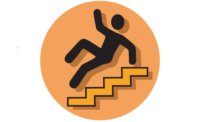Training is one of the most critical elements in safety. Providing workers with the required skills and knowledge to safely do their work is extremely important to OSHA. So important, in fact, that more than 100 of OSHA’s current standards contain specific training requirements, including newly revised Subpart D, “Walking-Working Surfaces.”
Some of these standards require “training” or “instruction,” while others require “adequate” or “effective” training or instruction. Regardless of the precise regulatory language, these requirements reflect OSHA’s belief that training is an essential part of every employer’s safety and health program. This belief is reiterated in the preamble to the walking-working surfaces final rule, which says, “OSHA believes that the new training requirements are necessary, and effective worker training is one of the most critical steps employers can take to prevent employee injuries and fatalities.”
WWS training requirements
Under the requirements at 29 CFR 1910.30, “Training,” employers must train – and retrain – employees as follows.
Which employees must be trained?
If an employee uses personal fall protection systems (e.g., travel restraint) and/or equipment specified under Subpart D (e.g., ladders), or is engaged in certain work situations (e.g., employees operating motorized equipment on dockboards not equipped with fall protection) they must be trained. OSHA says that fall protection systems and equipment will be effective only if they are installed, inspected, used, maintained, and stored properly and safely. The agency believes that workers need special and specific knowledge to perform these tasks correctly.
When must training be done?
Newly-hired and current workers must be trained before initially assigning them to a job where they may be exposed to a fall hazard. OSHA says workers who have already received training, either from your company or another employer, that meet all the requirements of 1910.30 do not need additional initial training. However, OSHA warns that many of these training requirements are new, and if the training workers already have does not meet all of the requirements in revised Subpart D, additional training on those requirements must be provided.
For example, if initial ladder training did not include specific instruction on how to climb a ladder in accordance with new 1910.23(b)(11), (12), and (13), then retraining would be necessary.
How must training be delivered?
Training may be delivered using different formats (e.g., classroom, demonstration, written, video) and technology (e.g., online, interactive computer-based, web-based) provided that:
- It’s delivered in a manner each worker understands; and
- A qualified person developed or prepared the training.
If providing training that is either web-based or interactive computer-based, a qualified person must be available to answer any questions workers may have. Keep in mind that it is the trainer who must be qualified, not the training materials used. As such, the trainer should use as many types of formats, technology, company-specific information, etc. as necessary to ensure training is effective.
Who must conduct the training?
The trainer (i.e. qualified person) must have a degree, certificate, or professional standing OR extensive knowledge, training, and experience to solve or resolve problems relating to the:
- Subject matter (e.g., how to use a designated area),
- Work (e.g., working on a roof), or
- Project.
OSHA is clear that trainers do not have to possess a degree if they have the necessary knowledge, training, and experience to be qualified.
Also, OSHA says that a competent person is not a qualified person. The Agency believes that competent personnel “qualified” to train workers in all of the subjects and topics specified under 1910.30 must have the capabilities of qualified persons. These capabilities extend beyond the current definition of a competent person. In other words, a qualified person has to meet a higher threshold of requirements then does a competent person.
Still, OSHA says it believes that many employers can draw upon the extensive knowledge and experience of their staffs to provide effective training, and that crew chiefs, supervisors, operations personnel, and other individuals at your facility – provided they have the necessary degree or extensive knowledge, training, and experience – can train workers.
What must the employee understand?
After training has been completed, the employee must be able to:
- Recognize fall hazards;
- Minimize these fall hazards; and
- Correctly install, set-up, inspect, operate/use, maintain, disassemble, and/or store the fall protection systems and equipment they use.
OSHA says in order to be effectively protected in the workplace, an employee must be able to first recognize fall hazards to which they may be exposed. In other words, training cannot be general in this regard. It must be specific to the fall hazards in their work area.
Retraining
Like many other OSHA standards, you must also retrain workers under 1910.30 when:
- Changes in the workplace render previous training invalid,
- Changes in the types of fall protection systems or equipment render previous training invalid, or
- The employee demonstrates a lack of understanding or skill necessary to use equipment or perform the job safely.
For example, if a worker is involved in an incident or a near-miss retraining would be necessary. If a worker was using a portable ladder unsafely by standing on a top step retraining would be necessary. Also, if a worker was working outside the warning line of a designated area retraining would be necessary.
OSHA says that it is an ongoing responsibility of employers to maintain worker
proficiency.
Recordkeeping
There is no requirement to keep records under 1910.30. OSHA states in the publication, “Training Requirements in OSHA Standards,” however, that it is a good idea to keep a record of all safety and health training. This serves several important purposes, including demonstrating compliance with applicable standards.
OSHA also says that documentation can supply an answer to one of the first questions an incident investigator will ask:
“Did the employee receive adequate training to do the job?”
Elevate your training program
Slips, trips, and falls continue to be a significant hazard in general industry workplaces. Each year, thousands of incidents result in lost-work days, permanent disability, and even death. OSHA estimates that implementing the new Subpart D requirements, including the training provisions, will annually prevent nearly 30 fatalities and 6,000 injuries due to slips, trips, and falls.



